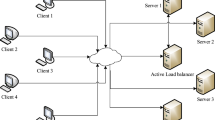Abstract
This article introduces the special network topology for the voice network system. Based on the overall design of the dedicated voice network system and the consideration of practical applicability, the performance requirements of the voice network system are very high. The system must not only ensure real-time performance, but also have a good expansion space, and also has high requirements for the transmission of text information. This article mainly uses a dedicated network to analyze the real-time performance of the voice network system. The network is based on the RS485 bus structure, and the overall voice signal transmission is also realized by this. This also makes the network structure more concise, and the overall design becomes simpler and more reliable. In recent years, research on optimizing the performance of wireless Mesh networks has gradually become a boom. The system analysis of this article is based on its basic principles and related research status, focusing on the joint optimization algorithm of routing and scheduling across layers. In the context of the continuous development of modern information science and technology, traditional college English education is being greatly impacted by advanced educational technology and brand-new teaching concepts and methods. Online teaching platforms such as “flipped classroom” have attracted widespread domestic attention and have achieved a large number of research results. This article draws on typical cases of “flipped classroom” to analyze the effectiveness of college students’ English learning.







Similar content being viewed by others
References
Akçayır G, Akçayır M (2018) The flipped classroom: a review of its advantages and challenges. Comput Educ 126:334–345
Burke AS, Fedorek B (2017) Does flipping promote engagement?: a comparison of a traditional, online, and flipped class. Act Learn High Educ 18(1):11–24
Dong C, Franklin R (2021) From the digital internet to the physical internet: a conceptual framework with a stylized network model. J Bus Logist 42(1):108–119
Hamidi M, Satori H, Zealouk O, Satori K, Laaidi N (2018) Interactive voice response server voice network administration using hidden Markov model speech recognition system. In: 2018 Second world conference on smart trends in systems, security and sustainability (WorldS4). IEEE, pp 16–21
Khanh QV, Hoai NV, Manh LD, Le AN, Jeon G (2022) Wireless communication technologies for IoT in 5G: vision, applications, and challenges. Wirel Commun Mob Comput 2022:1–12
Liu Q, Cheng L, Jia AL, Liu C (2021) Deep reinforcement learning for communication flow control in wireless mesh networks. IEEE Netw 35(2):112–119
Lu H, Xiaoyu Y, Haodong W, Jin L, Xuejiao M, Caihong Z (2020), March research on application of digital signal processing technology in communication. In: IOP conference series: materials science and engineering, vol 799, no 1. IOP Publishing, p 012026
Nurlan Z, Kokenovna TZ, Othman M, Adamova A (2021) Resource allocation approach for optimal routing in IoT wireless mesh networks. IEEE Access 9:153926–153942
Olimov SS, Mamurova DI (2022) Information technology in education. Pioneer: J Adv Res Sci Prog 1(1):17–22
Quesada-González D, Merkoçi A (2017) Mobile phone-based biosensing: an emerging diagnostic and communication technology. Biosens Bioelectron 92:549–562
Shahdad SY, Sabahath A, Parveez R (2016) April architecture, issues and challenges of wireless mesh network. In: 2016 International conference on communication and signal processing (ICCSP), IEEE, pp 0557–0560
Taleb SM, Meraihi Y, Gabis AB, Mirjalili S, Ramdane-Cherif A (2022) Nodes placement in wireless mesh networks using optimization approaches: a survey. Neural Comput Appl 34(7):5283–5319
Yang M, Yeh CH, Zhou Y, Cerqueira JP, Lazar AA, Seok M (2018) A 1µW voice activity detector using analog feature extraction and digital deep neural network. In: 2018 IEEE international solid-state circuits conference-(ISSCC). IEEE, pp 346–348
Zhang C, Khan I, Dagar V, Saeed A, Zafar MW (2022) Environmental impact of information and communication technology: unveiling the role of education in developing countries. Technol Forecast Soc Chang 178:121570
Zhao S, Yu G (2021) Channel allocation optimization algorithm for hybrid wireless mesh networks for information physical fusion system. Comput Commun 178:212–220
Zhong K, Zhou X, Huo J, Yu C, Lu C, Lau APT (2018) Digital signal processing for short-reach optical communications: a review of current technologies and future trends. J Lightwave Technol 36(2):377–400
Funding
This study and all authors have received no funding.
Author information
Authors and Affiliations
Corresponding author
Ethics declarations
Conflict of interest
The author reports no conflicts of interest.
Ethical approval
This article does not contain any studies with human participants performed by any of the authors.
Informed consent
Not applicable.
Additional information
Publisher’s Note
Springer Nature remains neutral with regard to jurisdictional claims in published maps and institutional affiliations.
Rights and permissions
Springer Nature or its licensor (e.g. a society or other partner) holds exclusive rights to this article under a publishing agreement with the author(s) or other rightsholder(s); author self-archiving of the accepted manuscript version of this article is solely governed by the terms of such publishing agreement and applicable law.
About this article
Cite this article
Jingning, L. Application of voice network analysis and scheduling joint optimization in the analysis of English learning effectiveness. Int J Syst Assur Eng Manag (2023). https://doi.org/10.1007/s13198-023-02113-w
Received:
Revised:
Accepted:
Published:
DOI: https://doi.org/10.1007/s13198-023-02113-w




